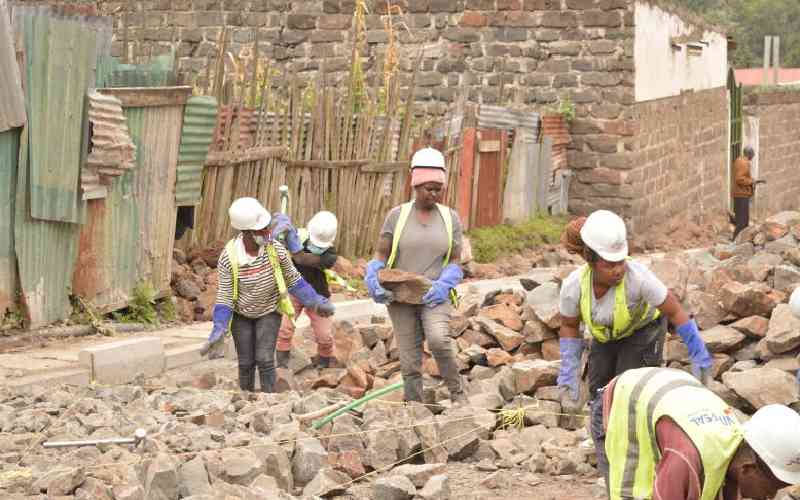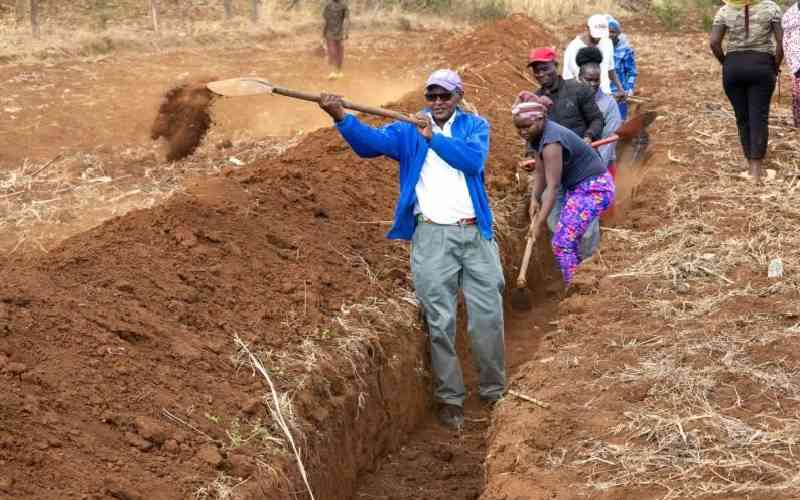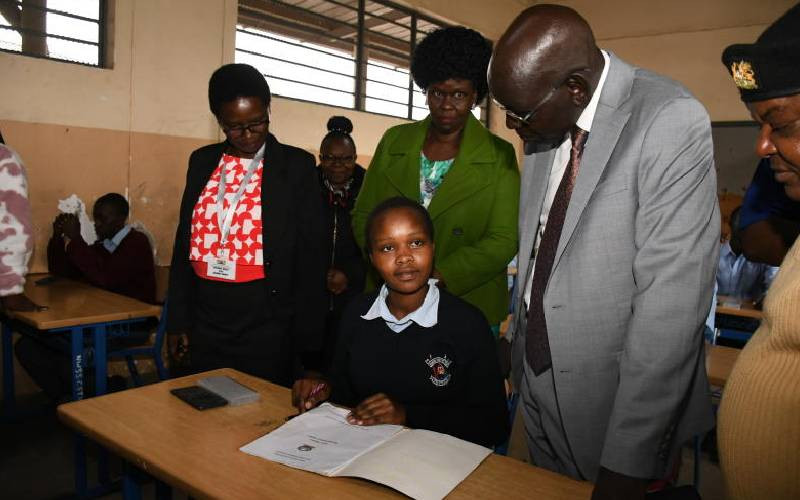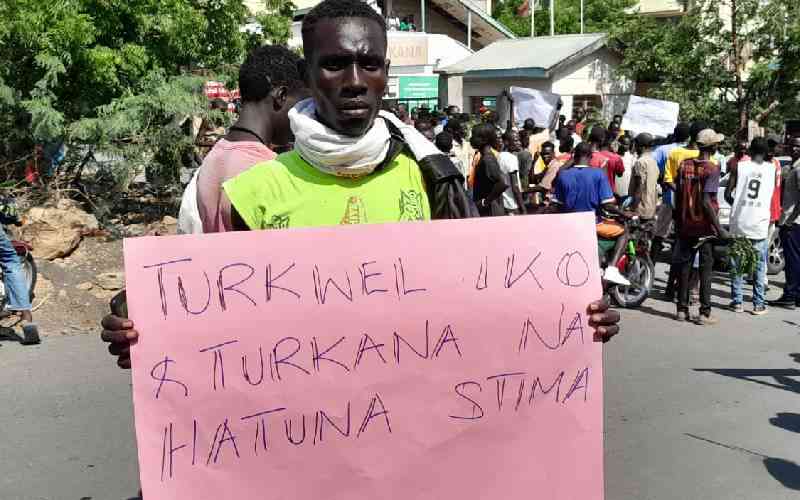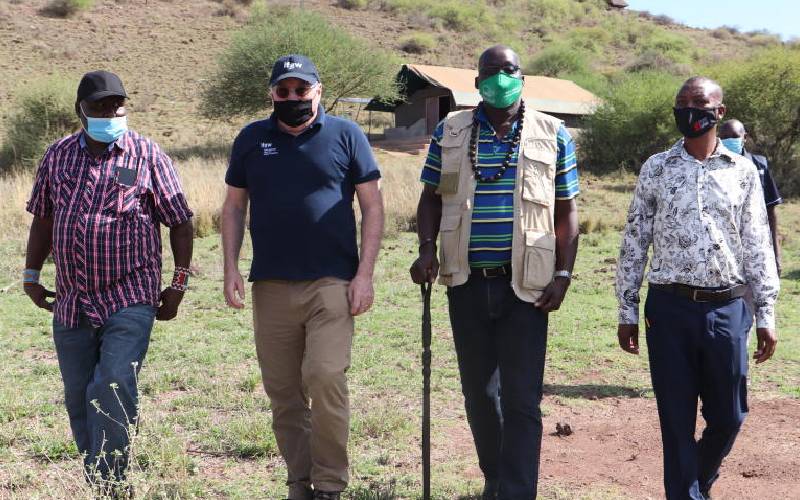
Royal Highness Senior Chief for Zimbabwe Siphoso Alphius Msindazi (right), Royal Highness Senior Chief in Malawi Felix Lukwa (2nd right) accompanied by IFAW President & CEO Azzedine Downes (2nd left) and one of the Maa community leaders at the Kitenden Conservancy in Kajiado South. [Robert Menza, Standard]
It was a watch, learn and share experience for delegations from two African countries that visited Kenya’s idyllic Amboseli National Park.
Visiting traditional chiefs from Malawi and Zimbabwe, each with a delegation of government officials involved in wildlife conservation, were amazed how Kenyan Maasai's lived freely with roaming wildlife.
The tribal chiefs wield influence in their respective countries, as they have access to government leaders, including presidents.
Senior Chief Felix Lukwa from Kasugu in Central Malawi, and Zimbabwe’s Royal highness Chief Siphoso, Alphius Msindaxi of the Tshosholotso community were impressed by what they observed after landing at the Amboseli airstrip last week. “Back home we cannot live with wildlife. This is the complete opposite here, as, during a well-deserved game drive, we encountered herders and their livestock not far away from where we saw herds of African jumbos grazing. This is quite amazing,” Chief Lukwa said.
Siphoso said he had great lessons to take back to his country after seeing how the local communities lived side by side with wildlife. “I am short of words. I have seen with my own eyes how communities live here harmoniously with nature. They see and derive value as a result of tourism-related activities,” he said at the Amboseli Serena Lodge.
He said their visit not only sought to cement friendly relations among African communities bordering protected areas, but also served as a real-life lesson on what the Kenyan Maasais were doing for wildlife posterity.
Lukwa said at Kasugu National Park, which is 2,316 square kilometres and the second largest national park in Malawi, they hoped to achieve intensified collaborations among African traditional chiefs living next to national parks and game reserves.
“It is our humble plea to the International Fund for Animal Welfare (IFAW) leadership here that they facilitate, just as they have done for this particular meeting, a bigger one that will bring together all traditional African chiefs in the continent whose villages border wildlife conservation areas,” he said.
He said from his visit, he had learnt that the Kenya Maasais saw wildlife as a revenue generator, unlike in Malawi where jumbos were viewed as huge source of meat.
“We shall definitely reciprocate from what we have learnt from this visit and help bridge the huge gap to help change the way our people back home see wildlife,” Lukwa said.
The meeting convened by IFAW saw the visiting leaders meet and integrate with local Maasai leaders involved in wildlife conservation, among them Daniel Leturesh of the Olgulului-Ololarashi Community Group Ranch, Joseph Sayialel, chairperson of the Kitenden Community Wildlife Conservancy and Jackson Mwato, the Executive Director of the Amboseli Ecosystem Trust.
Mr Sayialel welcomed the chiefs to Amboseli and explained how their collaborative approach with IFAW had led to many benefits for locals, while at the same time ensuring wildlife conservation.
IFAW President and CEO Azzedine Downes said the traditional leaders meeting in Amboseli provided ample opportunities to share ideas and experiences that will ensure humans and wildlife thrive in their shared habitats.
Mr Downes said traditional leaders played a vital role in convening and facilitating transparent and collaborative processes anchored in indigenous culture, norms and values. “Between them, these local leaders represent well over 100,000 people who live alongside wildlife,” said Downes.
Downes said they hoped the visiting delegations learnt from the Kenyan experience and would replicate the conservancy model in their countries.
“Room to Roam (R2R) or transboundary initiative (tBi) is an approach that advocates securing land for wildlife across diverse landscapes at a cross country/transboundary level. The plan is to partner with local communities, governments, financial donors to lease land, which is done in Amboseli and other parts of Kenya like the Mara,” he said.
He said they believed the meeting was the first of its sort — a trailblazing opportunity for the chiefs to discuss the real-life challenges faced by their communities and explore solutions for successful human-wildlife coexistence.
IFAW supports projects in each of the three countries with strong community engagement elements.
Amboseli’s Kitenden Community Wildlife Conservancy takes a land lease wildlife conservation approach. In 2013, IFAW secured 26,000 acres of wildlife habitat from 26,000 landowners and plans to lease another 29,000 acres in the same ecosystem.
“IFAW’s conservation model is to link fragmented landscapes to allow elephants and other migratory species room to roam safely and the communities sharing the landscapes space to thrive alongside them. Our intention is to stop poaching, support communities and rescue, rehabilitate and release animals back into the wild,” he said. “We cannot do this without community support. This meeting of influential chiefs might be the first, but won’t be last. We want to create lasting connections and even long-term friendships across Africa that lead to happy coexistence between communities and the wildlife with which they share their lives,” Downes said.
The Kitenden Conservancy lease provides clean water to leased lands, creates conservancies for tourism investment and provides infrastructure such as roads.
The local community also benefits from a scholarship programme. Job opportunities as community wildlife rangers or in Amboseli’s scenic tourist lodges are also available.
 The Standard Group Plc is a multi-media organization with investments in media platforms spanning newspaper print
operations, television, radio broadcasting, digital and online services. The Standard Group is recognized as a
leading multi-media house in Kenya with a key influence in matters of national and international interest.
The Standard Group Plc is a multi-media organization with investments in media platforms spanning newspaper print
operations, television, radio broadcasting, digital and online services. The Standard Group is recognized as a
leading multi-media house in Kenya with a key influence in matters of national and international interest.

